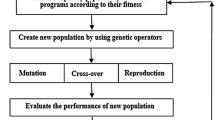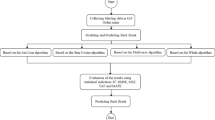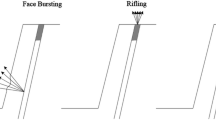Abstract
In bench blasting, backbreak is the unwanted result that causes instability to the highwall and can lead to safety hazards. Hence, it is utmost necessary to minimize the generation of backbreak to improve mine’s safety. It has always been difficult to predict the backbreak because of various parameters involved, i.e. blast design, explosive properties, rock mass, etc. In this study, multivariate regression analysis (MVRA) and genetic programming (GP) techniques were performed on 70 blast data sets of previously published papers. Both the models have been developed and tested with the same mine data set. For validation of the models, a total of 14 trial blasts have been conducted in Indian coal mines with different geological strata and other parameters. The values of R2, RMSE, MAPE and prediction level at 25% and 90% were computed for GP and MVRA techniques. Also, the GP model is compared with the other state-of-the-art techniques. It has been found that the level of prediction for validation data set at 25% using GP is 78.57% and for MVRA is 21.42%. The mean magnitude of relative error (MMRE) value for GP and MVRA is 0.18 and 0.42, respectively. The results show that the GP is a more efficient tool for prediction of backbreak in comparison with MVRA. On performing sensitivity analysis, it has been found that stemming length and powder factor are the most influencing parameters to backbreak.











Similar content being viewed by others
References
Fang Q, Nguyen H, Bui X-N, Nguyen-Thoi T (2020) Prediction of blast-induced ground vibration in open-pit mines using a new technique based on imperialist competitive algorithm and M5Rules. Nat Resour Res 29:791–806
Uyar GG, Aksoy CO (2019) Comparative review and interpretation of the conventional and new methods in blast vibration analyses. Geomech Eng 18:545–554
Agrawal H, Mishra AK (2018) Evaluation of initiating system by measurement of seismic energy dissipation in surface blasting. Arab J Geosci. https://doi.org/10.1007/s12517-018-3683-3
Sayadi A, Monjezi M, Talebi N, Khandelwal M (2013) A comparative study on the application of various artificial neural networks to simultaneous prediction of rock fragmentation and backbreak. J Rock Mech Geotech Eng 5:318–324. https://doi.org/10.1016/j.jrmge.2013.05.007
Ebrahimi E, Monjezi M, Khalesi MR, Armaghani DJ (2016) Prediction and optimization of back-break and rock fragmentation using an artificial neural network and a bee colony algorithm. Bull Eng Geol Environ 75:27–36. https://doi.org/10.1007/s10064-015-0720-2
Monjezi M, Rezaei M, Yazdian A (2010) Prediction of backbreak in open-pit blasting using fuzzy set theory. Expert Syst Appl 37:2637–2643. https://doi.org/10.1016/j.eswa.2009.08.014
Khandelwal M, Monjezi M (2013) Prediction of backbreak in open-pit blasting operations using the machine learning method. Rock Mech Rock Eng 46:389–396. https://doi.org/10.1007/s00603-012-0269-3
Ghasemi E, Amnieh HB, Bagherpour R (2016) Assessment of backbreak due to blasting operation in open pit mines: a case study. Environ Earth Sci. https://doi.org/10.1007/s12665-016-5354-6
Ghasemi E (2017) Particle swarm optimization approach for forecasting backbreak induced by bench blasting. Neural Comput Appl 28:1855–1862. https://doi.org/10.1007/s00521-016-2182-2
Agrawal H, Mishra AK (2018) Probabilistic analysis on scattering effect of initiation systems and concept of modified charge per delay for prediction of blast induced ground vibrations. Meas J Int Meas Confed 130:306–317. https://doi.org/10.1016/j.measurement.2018.08.032
Konya CJ, Walter EJ (1991) Rock blasting and overbreak control. United States. Federal Highway Administration
Sharma M, Choudhary BS, Kumar H, Agrawal H (2021) Optimization of delay sequencing in multi-row blast using single hole blast concepts. J Inst Eng Ser D. https://doi.org/10.1007/s40033-021-00270-5
Kumar S, Mishra AK, Choudhary BS (2021) Prediction of back break in blasting using random decision trees. Eng Comput. https://doi.org/10.1007/s00366-020-01280-9
Monjezi M, Dehghani H (2008) Evaluation of effect of blasting pattern parameters on backbreak using neural networks. Int J Rock Mech Min Sci. https://doi.org/10.1016/j.ijrmms.2008.02.007
Mohammadnejad M, Gholami R, Sereshki F, Jamshidi A (2013) A new methodology to predict backbreak in blasting operation. Int J Rock Mech Min Sci 60:75–81. https://doi.org/10.1016/j.ijrmms.2012.12.019
Agrawal H, Mishra AK (2018) A study on influence of density and viscosity of emulsion explosive on its detonation velocity. Model Meas Control C 78:316–336
Agrawal H, Mishra AK (2019) Modified scaled distance regression analysis approach for prediction of blast-induced ground vibration in multi-hole blasting. J Rock Mech Geotech Eng 11:202–207. https://doi.org/10.1016/j.jrmge.2018.07.004
Agrawal H, Mishra AK (2020) An innovative technique of simplified signature hole analysis for prediction of blast-induced ground vibration of multi-hole/production blast: an empirical analysis. Nat Hazards 100:111–132. https://doi.org/10.1007/s11069-019-03801-2
Gates WCB, Ortiz LT, Florez RM (2005) Analysis of rockfall and blasting backbreak problems, US 550, Molas Pass, CO. Am Rock Mech Assoc - 40th US Rock Mech Symp ALASKA ROCKS 2005 Rock Mech Energy, Miner Infrastruct Dev North Reg
Jimeno EL, Jimino CL, Carcedo A (1995) Drilling and blasting of rocks. CRC Press
Wang W, Wang Y, Wu Y et al (2019) Quantification of full left ventricular metrics via deep regression learning with contour-guidance. IEEE Access 7:47918–47928. https://doi.org/10.1109/ACCESS.2019.2907564
Shen W, Xu W, Zhang H et al (2020) Automatic segmentation of the femur and tibia bones from X-ray images based on pure dilated residual U-Net. Inverse Probl Imaging. https://doi.org/10.3934/ipi.2020057
Zhang Z, Duan C, Lin T et al (2020) GVFOM: a novel external force for active contour based image segmentation. Inf Sci (Ny) 506:1–18. https://doi.org/10.1016/j.ins.2019.08.003
Esmaeili M, Osanloo M, Rashidinejad F et al (2012) Multiple regression, ANN and ANFIS models for prediction of backbreak in the open pit blasting. Eng Comput 30:549–558. https://doi.org/10.1007/s00366-012-0298-2
Monjezi M, Amini Khoshalan H, Yazdian Varjani A (2010) Prediction of flyrock and backbreak in open pit blasting operation: a neuro-genetic approach. Arab J Geosci 5:441–448. https://doi.org/10.1007/s12517-010-0185-3
Monjezi M, Ahmadi Z, Varjani AY, Khandelwal M (2013) Backbreak prediction in the Chadormalu iron mine using artificial neural network. Neural Comput Appl 23:1101–1107. https://doi.org/10.1007/s00521-012-1038-7
Monjezi M, Hashemi Rizi SM, Majd VJ, Khandelwal M (2014) Artificial neural network as a tool for backbreak prediction. Geotech Geol Eng 32:21–30. https://doi.org/10.1007/s10706-013-9686-7
Ghasemi E, Bakhshandeh H, Raheb A (2016) Assessment of backbreak due to blasting operation in open pit mines : a case study. Environ Earth Sci 75:1–11. https://doi.org/10.1007/s12665-016-5354-6
Shirani Faradonbeh R, Monjezi M, Jahed Armaghani D (2016) Genetic programming and non-linear multiple regression techniques to predict backbreak in blasting operation. Eng Comput 32:123–133. https://doi.org/10.1007/s00366-015-0404-3
Saghatforoush A, Monjezi M, Shirani Faradonbeh R, Jahed Armaghani D (2016) Combination of neural network and ant colony optimization algorithms for prediction and optimization of flyrock and back-break induced by blasting. Eng Comput 32:255–266. https://doi.org/10.1007/s00366-015-0415-0
Hasanipanah M, Shahnazar A, Arab H et al (2017) Developing a new hybrid-AI model to predict blast-induced backbreak. Eng Comput 33:349–359. https://doi.org/10.1007/s00366-016-0477-7
Fattahi H, Hasanipanah M (2020) Prediction of blast-induced ground vibration in a mine using relevance vector regression optimized by metaheuristic algorithms. Nat Resour Res 1–15
Faradonbeh RS, Armaghani DJ, Majid MZA et al (2016) Prediction of ground vibration due to quarry blasting based on gene expression programming: a new model for peak particle velocity prediction. Int J Environ Sci Technol 13:1453–1464
Choudhary SSK, Ranjan R (2014) Blast vibration monitoring in opencast mines
Nguyen H, Drebenstedt C, Bui X-N, Bui DT (2020) Prediction of blast-induced ground vibration in an open-pit mine by a novel hybrid model based on clustering and artificial neural network. Nat Resour Res 29:691–709
Sari M, Ghasemi E, Ataei M (2014) Stochastic modeling approach for the evaluation of backbreak due to blasting operations in open pit mines. Rock Mech Rock Eng 47:771–783. https://doi.org/10.1007/s00603-013-0438-z
Faradonbeh RS, Armaghani DJ, Monjezi M, Mohamad ET (2016) Genetic programming and gene expression programming for flyrock assessment due to mine blasting. Int J Rock Mech Min Sci 88:254–264. https://doi.org/10.1016/j.ijrmms.2016.07.028
Faradonbeh RS, Jahed Armaghani D, Monjezi M (2016) Development of a new model for predicting flyrock distance in quarry blasting: a genetic programming technique. Bull Eng Geol Environ 75:993–1006. https://doi.org/10.1007/s10064-016-0872-8
Dolado J, Fernández L (1998) Genetic programming, neural networks and linear regression in software project estimation. Int. Conf. Softw. Process Improv. Res. Educ. Training. 157–171
Acknowledgements
For analysis and discussion of this study, the data set has been taken from previous research papers [28, 29], and all the data are produced in Table 2.
Funding
This research did not receive any specific grant from funding agencies in the public, commercial, or not-for-profit sectors.
Author information
Authors and Affiliations
Corresponding author
Ethics declarations
Conflict of interest
The authors declare that they have no conflict of interest.
Additional information
Publisher's Note
Springer Nature remains neutral with regard to jurisdictional claims in published maps and institutional affiliations.
Rights and permissions
About this article
Cite this article
Sharma, M., Agrawal, H. & Choudhary, B.S. Multivariate regression and genetic programming for prediction of backbreak in open-pit blasting. Neural Comput & Applic 34, 2103–2114 (2022). https://doi.org/10.1007/s00521-021-06553-y
Received:
Accepted:
Published:
Issue Date:
DOI: https://doi.org/10.1007/s00521-021-06553-y




